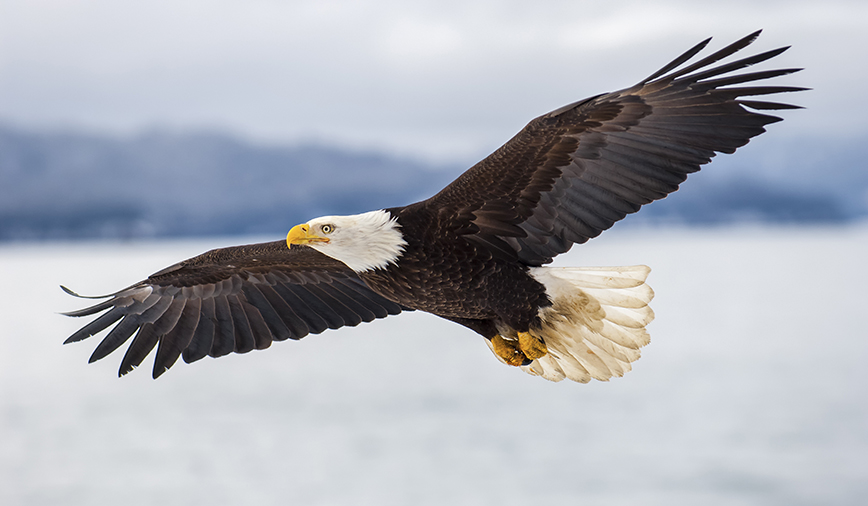January 17, 2014
The Bald Eagle
I was chatting on the phone with my friend Barb the other night, and we were trying to come up with the names of all the Eagles: Don Henley…Glenn Frey…Joe Walsh…that other guy…
What I should’ve suggested—and what would’ve been way easier—is that we try to name all the places eagles are being sighted these days: The Ones in SEBA Park in South Elgin. The Ones at Mount St. Mary Park in St. Charles. The Ones in Geneva, South of the Dam. And many, many more…
Once federally endangered and teetering toward extinction, the bald eagle, Haliaeetus leucocephalus, has become an increasingly common sight in and around the Fox River Valley.
This trend is even more obvious right now, thanks to the harsh winter we and our neighbors to the north are experiencing.
Bald eagles are piscivores—fish-eaters—by preference and so tend to inhabit areas near lakes or streams. But when the temperature drops, the water freezes and hunting for fish becomes difficult. While other food sources like carrion may be adopted in the short run, a better long-term survival strategy is to head for open water. When a source—like our Fox River—is identified, bald eagles from near and far come in to take advantage.
It’s hard to say exactly where the eagles we’re seeing call home, but one clue may lie in the fact that Wisconsin experienced record numbers of of breeding bald eagle pairs and occupied nests in 2013. Some of those birds have no doubt headed for open stretches of the Mississippi and Wisconsin Rivers, but I’ll bet more than a few have made their way to Illinois, and our own Fox River.
Even if you’re not into birding, it can be fun to go eagle-watching. For one thing, you don’t have to fuss much with field guides. Mature bald eagles are pretty unmistakable: Majestic white heads and tails standing in stark contrast to dark brown, almost black, bodies.
These guys are big, too. They measure 30 in. from bill to tail and weigh almost 10 lbs., which is a lot for a bird. Their outstretched wings measure 80 in., a span that is simultaneously impressive and hard to miss.
But if you’re one of those individuals who prefers more of a challenge to your birding endeavors, bald eagles deliver on that front too. Immature birds look very different from adults.
First-year eagles are nearly all dark brown. Their bill and eyes are dark too. But in subsequent years, whitish feathers creep in among the dark ones and the birds take on a more mottled appearance. By year four a young eagle looks very much like an adult, with only a few streaks of brown on its white head and a few streaks of white on its brown body. The bill is nearly all yellow and the eyes have lightened considerably. From age five on, bald eagles are considered mature.
Interested in trying your luck at spotting an eagle? Although you can sometimes find them away from the Fox River (I remember watching an immature at Nelson Lake Marsh in Batavia several years ago, pecking away at a dead fish frozen in ice) your best bet is to head for a free-flowing stretch of river. Close by, current hot spots include SEBA Park in South Elgin; Mount St. Mary Park in St. Charles; Island Park in Geneva; the north Batavia Dam; behind Funway where the south Batavia dam was removed a few years ago; and the riffled, unfrozen segments between Montgomery and Oswego.
If you want to travel a little farther afield, head down to Starved Rock State Park.You can get decent views of the birds from the park’s namesake Rock, but you can get even closer to the action at the Illinois Waterway Visitors Center across the river. (Travel Hint: The popular Bald Eagle Watch Weekend takes place January 25 and 26, with lots of family-oriented programs and activities slated at both facilities.)
If you do head that way, whether it’s Bald Eagle Weekend or not, don’t forget to look down as well as up. Along the shoreline underneath the trees on Plum Island, which is just downstream from the Waterway Visitors Center, you’re likely to see some other notably large birds: great blue herons, taking advantage of a free meal of fish chunks raining down as the eagles feed above.
Expect these greater-than-usual numbers of eagles to last until the spring thaw. Then, as waters begin to open up again, the birds will disperse and head back to their home ranges.
In the meantime, make some plans to get out and watch them soar, dive, perch and feed. It’s a great show, one you won’t want to miss. Plus, you can tell your friends you went to see a performance by Haliaeetus leucocephalus. Or, if you want, you can just call them the Eagles.
Pam Otto is the manager of nature programs and interpretive services at the Hickory Knolls Discovery Center, a facility of the St. Charles Park District. She can be reached at 630-513-4346 or potto@stcparks.org.

